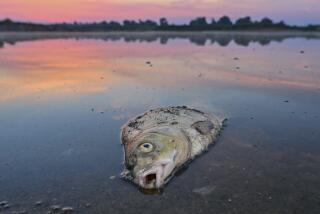Poachers Threaten Ecology of Russia’s Far East
- Share via
VLADIVOSTOK, Russia — Two Chinese poachers pour herbicides into a shallow Russian river, and minutes later dozens of dead frogs come belly up. One of the poachers, clad in a khaki jacket and high rubber boots, wades into the water and stuffs the limp bodies into a plastic bag.
Russian border guards videotaped the scene last year as evidence of a practice Chinese poachers began using widely last year -- allegedly poisoning about 10 Russian rivers near the border with China. Officers then detained the pair and handed them over to China.
From frogs to endangered leopards, animals in Russia’s Far East have suffered from proximity to China, where poachers cater to a lively trade in creatures believed to have unique healing powers and culinary cachet.
Scores of poachers cross the border every year to cull animals and plants from forests, rivers and bays, authorities and ecologists say. Sometimes they use poison, sometimes electricity generators and electrodes that they stick into water to electrocute aquatic creatures.
“This is ecological terrorism,” said Pavel Fomenko of the World Wildlife Fund.
Poisoning rivers gives poachers quick and easy access to the frogs that are considered a delicacy in China, Fomenko said. Buyers of poisoned frogs either don’t suspect that they are poisoned or believe that cooking neutralizes the toxin, he speculated. He estimates poachers could sell the dried frogs for about $300 a kilogram in China, about 10 times more than they pay Russian frog hunters. A kilo contains about 200 dried frogs.
Herbicides also kill fish and other water creatures, and contamination drifts downstream, endangering anyone who drinks from the river, the ecologist said.
Albina Proskurenko, a spokeswoman for Russia’s Federal Border Service in Vladivostok, said the poison seized from Chinese poachers is normally used to kill insects in rice fields and is very potent.
Last year, Russian border guards sent four notes of protest to their Chinese counterparts over river-poisoning cases and were still waiting for a response, she said. Russia usually sends poachers back to China, where they face fines or prison terms, according to the spokeswoman.
Two other species under threat are Siberian tigers and Far Eastern leopards, whose hides and bones are used in traditional Chinese medicine. Police confiscated five leopard hides from Russians last year and Fomenko said three of the leopards were killed on contract for Chinese traders. These cats face extinction, with only about 30 left in the wild, he said.
Some Chinese poachers enter the country as tourists, an easier tactic since Russia opened its borders in the 1990s; lately, the numbers have dropped because of Russian border restrictions introduced to prevent the spread of severe acute respiratory syndrome, or SARS.
But others still cross illegally, taking advantage of the long and loosely guarded border.
Poaching has only increased. In 1991, customs agents thwarted 11 attempts to smuggle out plants and animal parts while the number of such attempts increased tenfold last year, to 110, Fomenko said. The overwhelming majority of the contraband was bound for China.
Chinese authorities have done what they could to stop the flow of contraband animals and plants. According to Russian border guards, their Chinese counterparts regularly erect additional border outposts in the summer, when poachers are especially active. Chinese authorities in border areas also arrange public awareness campaigns aimed at discouraging citizens from poaching in Russia.
But those measures are too little to counter the threat, Russian ecologists and border officials say.
“Poaching will continue as long as it brings money,” Proskurenko said.
More to Read
Sign up for Essential California
The most important California stories and recommendations in your inbox every morning.
You may occasionally receive promotional content from the Los Angeles Times.













